






The overall aim of the TITAN project is to support small business ownermanagers, and their staff, to acquire appropriate sustainably responsible leadership and innovation skills which can implemented in a working context, as a way of achieving sustainable development goals alongside delivery of value to customers and other stakeholders
The TITAN project will achieve this aim through the development and delivery of a curriculum consisting of a set of complementary learning materials and resources including:
• A set of competence matrices, or modules, related to different aspects of sustainably responsible leadership and innovation
• A number of learning materials and resources (e.g. flipbooks, video guides)
• A set of assessment tools for small business owners managers and their staff
• An open educational video resource
The TITAN curriculum will enable small businesses and organisations to:
• Identify different ways of introducing and embedding sustainability in their business models
• Assess strengths and areas for development within their business
• Explore processes and practices which can be used to implement and embed sustainability
• Learn from the experiences of different businesses and organisations who have introduced sustainability in their business models and processes and practices.
A number of themes, or modules, underpin the TITAN curriculum including:
• Sustainably responsible management
• Business culture for sustainability and innovation
• Business ethics in leadership and innovation
• Embedding sustainability in business processes
• Business responsible innovation
• Holistic approaches to innovation.
Sustainability leadership is defined as ‘a process of influence that delivers direction, alignment and commitment, and aims to address social, environmental and economic issues to create a better world’ (McCauley, 2014) and sustainable leaders are ‘individuals who are compelled to make a difference by deepening their awareness of themselves in relation to the world around them. In doing so, they adopt new ways of seeing, thinking and interacting that result in innovative, sustainable solutions’ (Sustainability Leadership Institute, 2011).
Over the last five years or so, there has been an increasing number of articles, books and papers published on different aspects of how small businesses can embed sustainability into their business models and specific business processes and practices These come from academic institutions, research institutions, policy and professional bodies and business and entrepreneurship magazines. Whilst these articles, books and papers provide valuable insights into the case for introducing and embedding sustainability and generic tips and techniques, they can often be difficult to access and tease out the practical implications for introducing and embedding sustainability, particularly for small business owner-managers and their staff. There is a lack of tailored, or demand led resources which can assist small businesses in understanding current strengths and areas for development, making sense of the importance of different opportunities in their task environment to introduce sustainability and manage the journey from idea to action.
The flipbooks have been designed to address this gap. There are six flipbooks which relate to the key themes underpinning the TITAN curriculum, and they provide:
• An accessible overview of the state of current thinking
• Insights from other small businesses who reflect on what works well and less well in introducing and embedding sustainability into their business models
• Access to exercises to support reflection on own learning and skills development
• Access to useful resources on different aspects of introducing and embedding sustainably responsible leadership and innovation.
The flipbooks are complemented by:
• A series of TEDx type videos which reflect on different aspects of sustainably responsible leadership and innovation
• A range of micro-learning activities which provide you with an opportunity to assess your own understanding, behaviours and skills.
This flipbook explores the three constituting fields of Sustainably Responsible Management: sustainability, responsibility, and ethics. You will learn how to lead to change at a systemic level, support and bring together different opinions and approaches and negotiate cooperative solutions.
Today’s consumers demand that the businesses they deal with have the responsibility to make the world a better place to live, work, and play. Therefore, corporate social responsibility is more important now than at any point ever before in humanity. The new generation of consumers is ready to fight for what they believe in, such as environmental issues, ethical labour practices, and more. There is a demand for corporate social responsibility on several levels.
This is the reason why managers are more and more challenged with issues of sustainability and responsibility. Additionally, another significant challenge that is combined with sustainably responsible management is ethics. Sustainably Responsible Management is an integrative management approach based on three domains: sustainability, responsibility, and ethics
On the other hand, Peter Drucker in his book “The Essential Ducker” says that “Responsibility for social impacts is a management responsibility not because it is a social responsibility, but because it is a business responsibility” [3].
Rephrasing the above quote, we may say that responsible management itself is a pleonasm, an unnecessary “new” definition that offers no innovation to the overall meaning of management. The responsibility for the social impact of a manager’s activity is the natural essential component of good management and it does not need to be specifically stated. They must accomplish a positive social impact as one of their essential tasks to their organisations, to actively detect the social needs and turn them into business opportunities.
This chapter will first explain the main elements of management theory and demonstrate how they need to be changed to achieve responsible management practices Central questions are:
1) What are these three constituting domains of Sustainably Responsible Management: sustainability, responsibility, and ethics?
2) How can you apply the knowledge gained from these three domains in every day’s real-life challenges and facilitate individual actions that can lead to change on a systemic level?
3) How will you support and bring together different opinions and approaches and negotiate cooperative solutions to important challenges and problems?


Understanding management requires a clear clarification of the three basic elements of management. Those elements are clustered into three areas: management inputs, management process, and management output.
Figure 1: The three elements of management
Based on Figure 1, we define Management as the process of working with people and resources to achieve performance effectively, efficiently, and in line with pre-established objectives [2]
To achieve the predefined objectives, the management process requires two inputs: people and resources. The predefined objectives describe the expected outcome of the management process.
The management process is characterized by the efficiency and effectiveness of the executed activities. Efficiency is considered the proportion between resource input and management output and effectiveness is the degree to which the management process has contributed to the pre established objectives

A manager is responsible for translating the goals and objectives of the organisation to the people within their team. She/He should understand people, make sure they achieve their potential and enable them to fulfil goals and objectives rather than try to control things. A manager should encourage innovation and creativity and keep people motivated and satisfied.
Using the brainstorming training method, start a discussion with the trainees by answering the questions below Based on the trainees' answers, compare, and contrast them with the theories of management in the literature to see if theory meets practice.
• In your opinion, what is Management?
• What do you expect a manager to do?

Sustainably Responsible Management is usually known as Responsible Management and the businesses where Responsible Management is applied, are called Responsible Businesses.
“Traditional” Management can be evolved into a Responsible Management if each element of management, mentioned in the previous paragraph, is transformed into “responsible”. This “responsibility” is defined based on the three domains of Responsible Management: Sustainability, Responsibility and Ethics [2].
Therefore, the next step toward responsible management is to reconfigure and integrate sustainability, responsibility, and ethics in resources, objectives, efficiency, effectiveness, and performance. All elements should create value for stakeholders in all three domains, and at the same time, they achieve moral excellence
Responsible Management should embrace all three main domains, sustainability, responsibility, and ethics, in all management practices. Each of the three domains provides a unique perspective, but the domains also overlap and complement each other in their effects on management [2] The general guidelines provided by these issues are summarised in Figure 2.
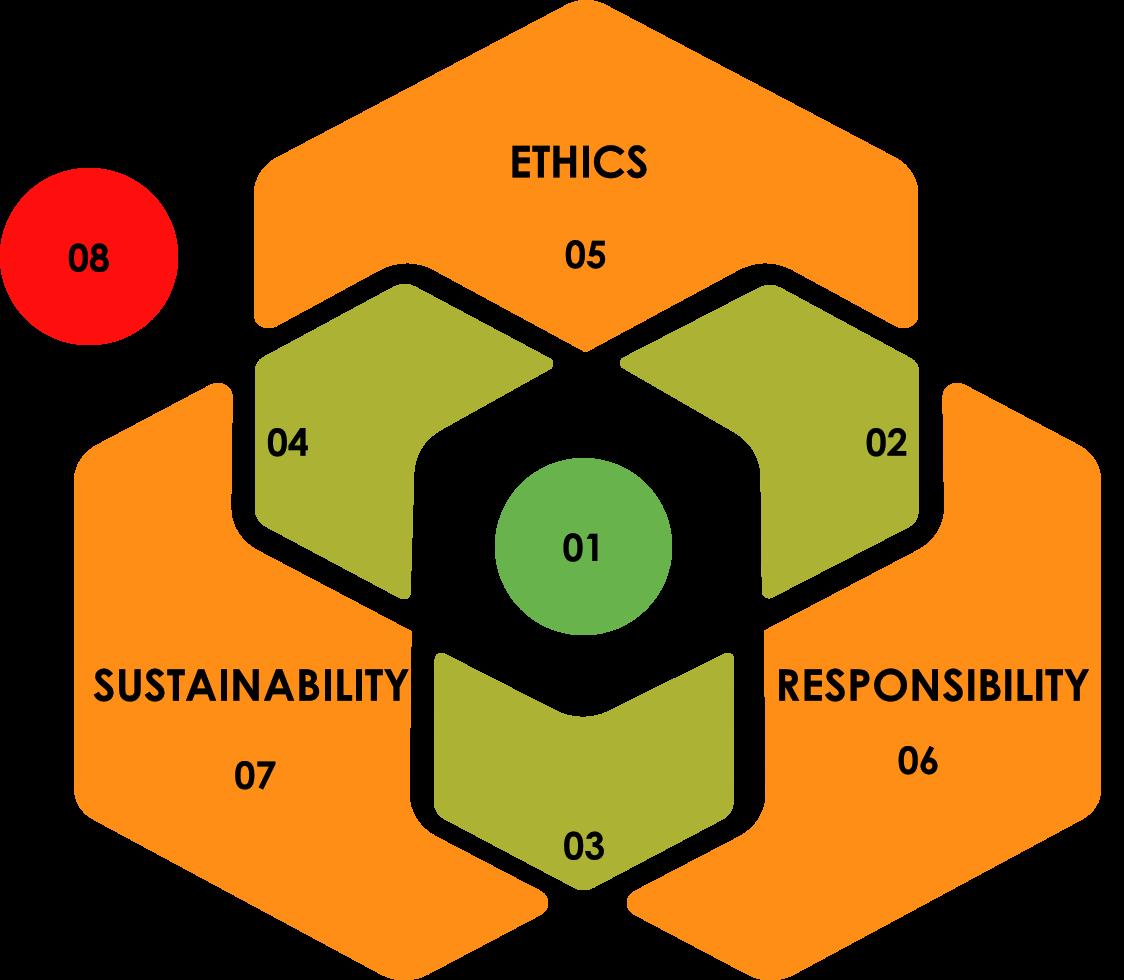
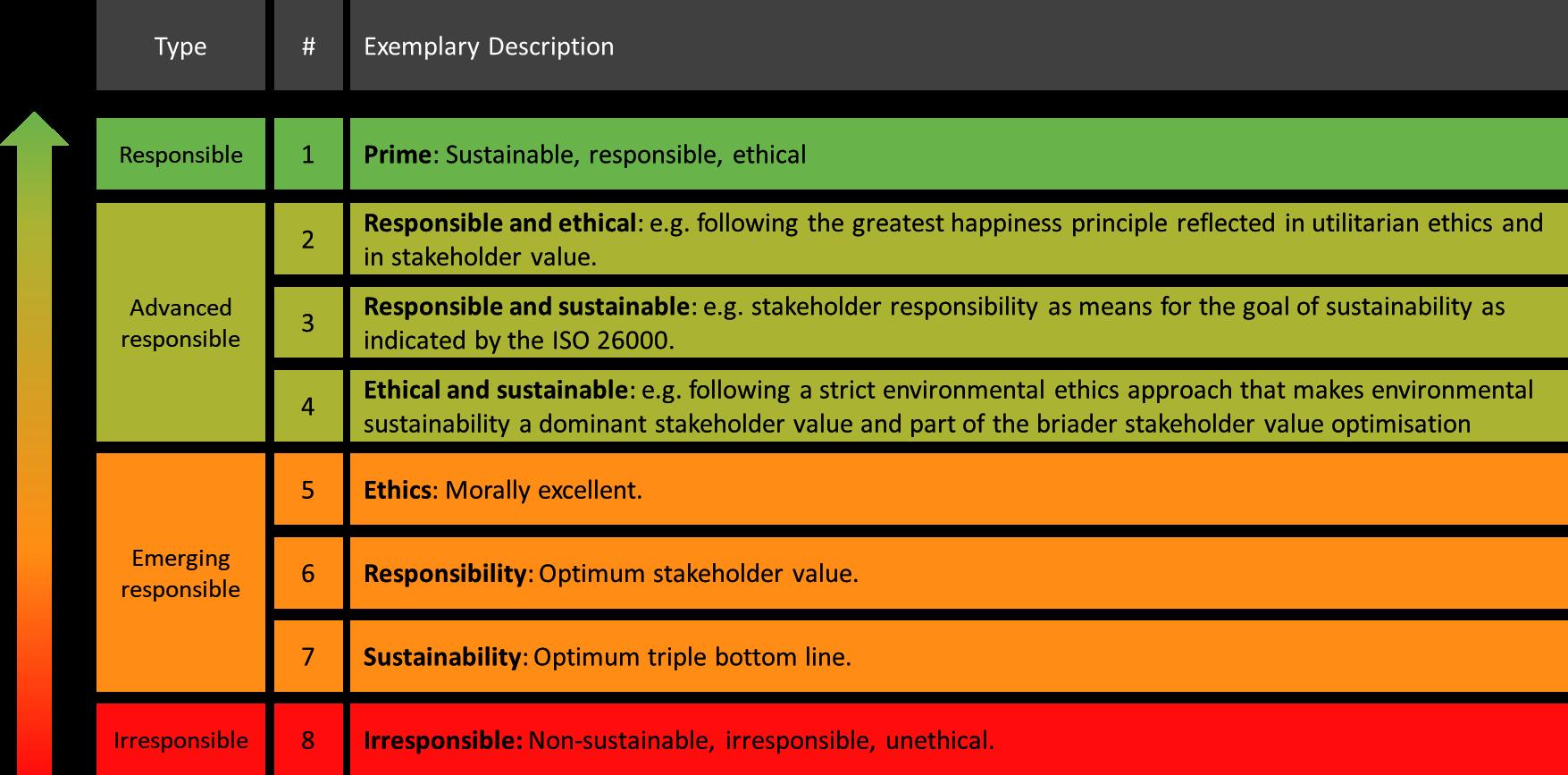
Sustainability is the management activity that must lead to a sound, positive triple bottom line that protects, creates, and sustains social, environmental, and economic business value Management practice must embrace triple bottom line optimization [2]
In a simpler definition, Sustainability means meeting our own needs without compromising the ability of future generations to meet their own needs, in natural resources, social and economic resources Sustainability is not just environmentalism. [5]
The Triple Bottom Line [5] is one method being used by organisations to assess their profits through their corporate sustainability solutions. The Triple Bottom Line method asks businesses to see beyond the traditional bottom line of business to the profits that they make socially, environmentally, and economically
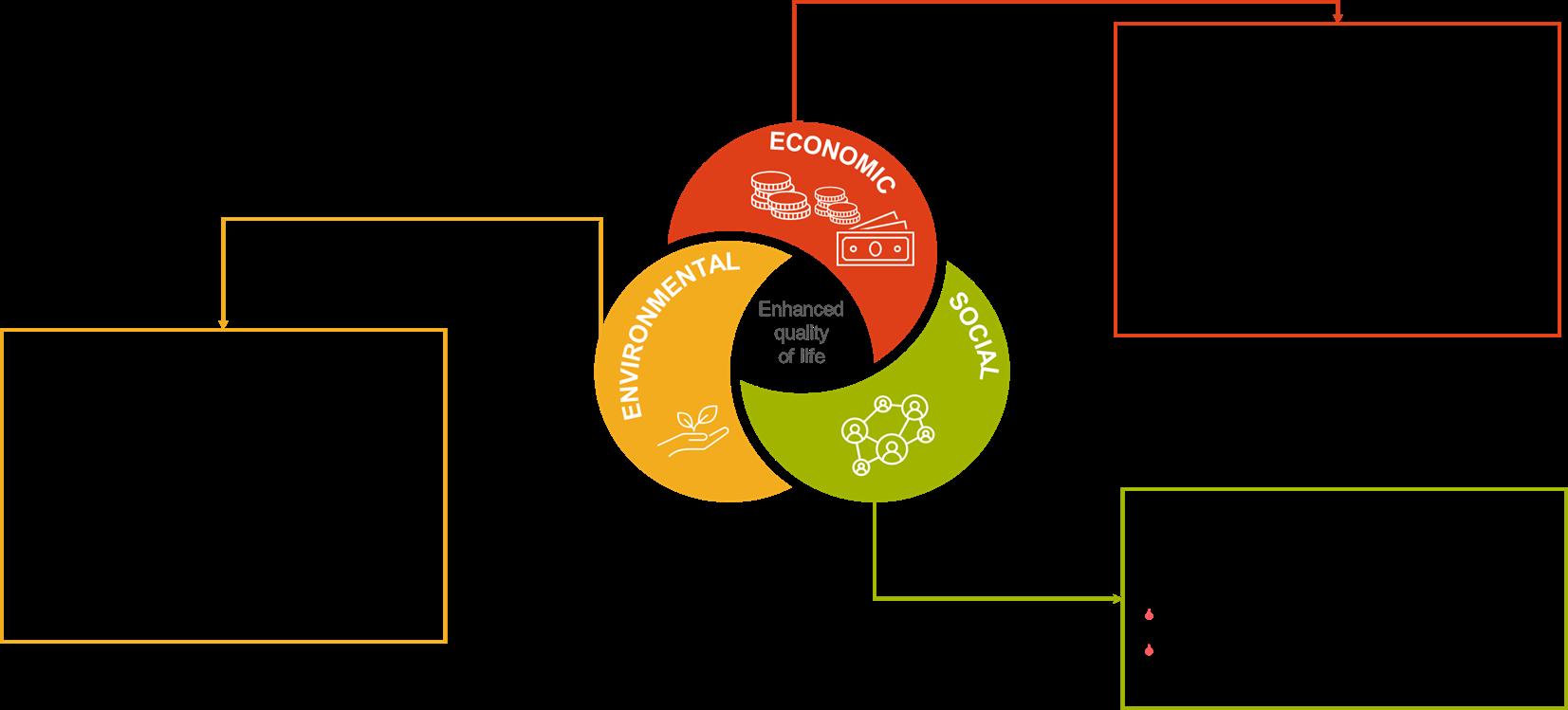
Responsibility is the management activity that leads to the optimization of overall stakeholder value, instead of the narrow focus on maximizing shareholder value. All management practices must embrace stakeholder value optimization [2]. This approach argues that an organization (and managers at all levels) is responsible for creating value for stakeholders (employees, suppliers, customers, society, environment, etc.) not only shareholders.
In the context of responsible management, the word employee should be replaced by the broader term “stakeholder”, in order to seek a balance between stakeholder orientation and performance orientation thinking. The relationship to responsible management is less competitive than in traditional management, as performance is redefined from the point of view of general stakeholders and not just shareholders
Ethics
Ethics is defined as the management’s decisions that should be morally desirable in both process and outcome Management practices should embrace ethical decision making and create moral excellence [2]. In today’s highly connected world, organisations should operate in transparency and take into consideration the interests of all stakeholders. Management should be realized that ethics and integrity is crucial as they can shift the organisational mindset from short-term gains to long-term sustainability
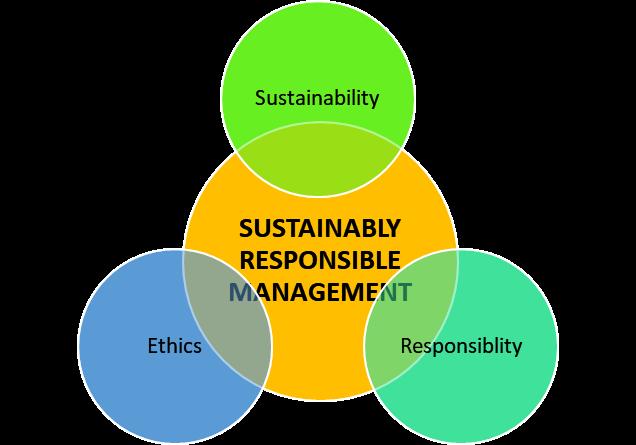

How do we transform traditional management into responsible management? In previous sections we refer to the possibility to change the three basic elements of management into “responsible” items This means that we inject sustainability, responsibility, and ethics aspects into those elements. Figure 5 below present the whole approach to this.
Figure 5 Management Transformation
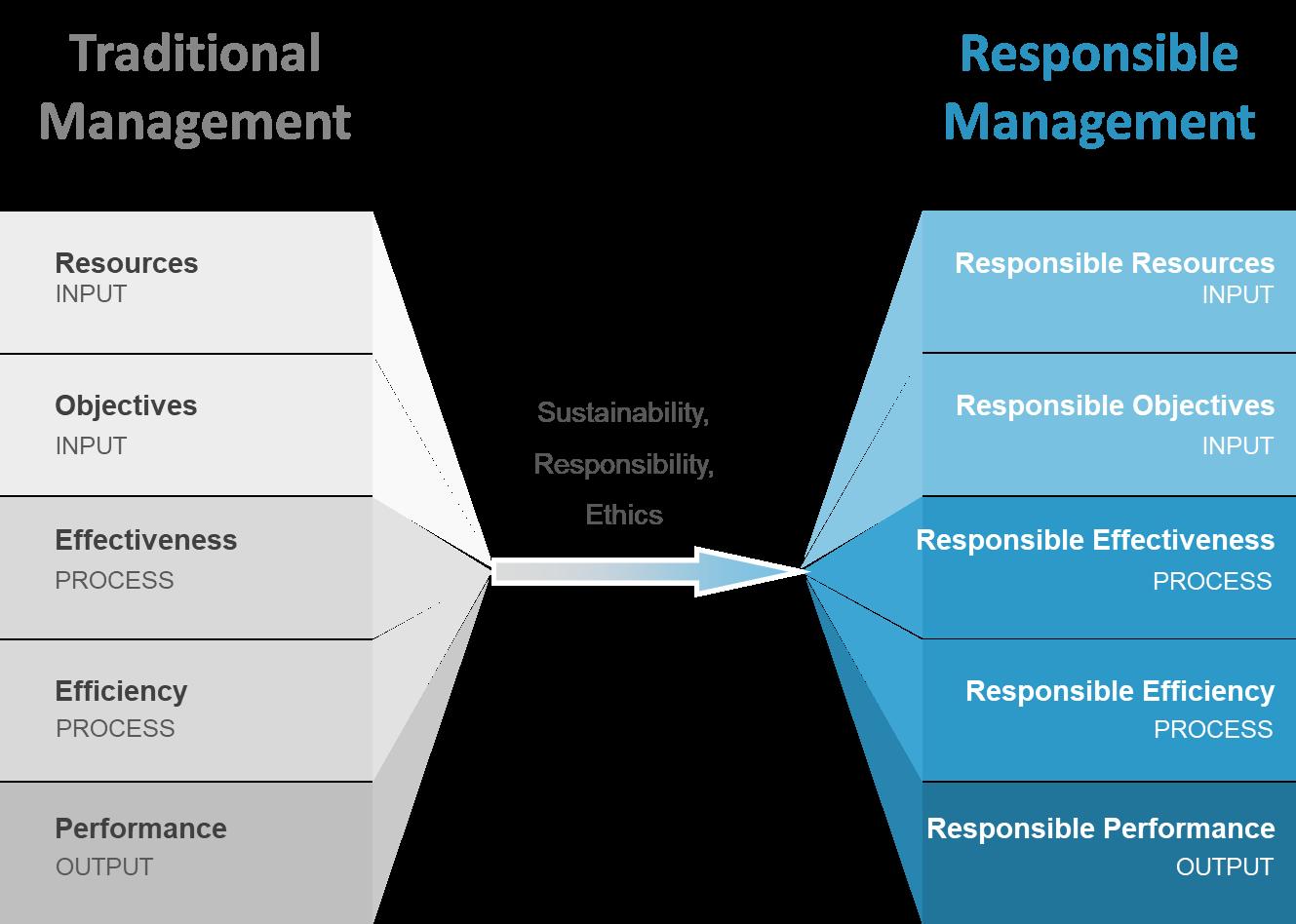
In Laasch O. and Conaway R. book, “Principles of Responsible Management: Global Sustainability, Responsibility, Ethics” [2], can be found the definitions where three domains of the responsible management are embraced.
Responsible management objectives should aim at creating value for stakeholders and ethical excellence in all three domains (sustainability, responsibility, ethics) and responsible management resources are the social, environmental, and economic capital, the stakeholder inputs, and the ethical capital [2].
Responsible management effectiveness is measured by the amount of triple bottom line value and stakeholder value created and the degree of moral excellence achieved, whereas the responsible management efficiency is measured by the ratios between the triple bottom line capital used and created, the stakeholder input and value created, and the moral issues encountered, and moral excellence achieved throughout the management process [2].s
At the output of the management flow, responsible management performance is the product of the responsible management effectiveness and efficiency achieved.
This integrated model of sustainably responsible management can be considered as the highest level in the evolution of responsible business thinking, as it integrates the three main domains of sustainability, responsibility, and ethics as separate and equally important foundations for responsible business.
In responsible management, the term stakeholder should be used with the broader meaning for employees, suppliers, customers, etc., to achieve a balance between stakeholder orientation and performance orientation thinking.
The performance in responsible management is redefined in relation to general stakeholders, instead of only shareholders, and this creates a less competitive environment than in traditional management. The practices applied in responsible management are highly motivating for employees, since those practices reduce dissatisfiers (e.g., bad reputation, poor work conditions) and strengthen satisfiers (e.g., meaningfulness of work, self fulfillment through work).
How do we define “responsible” the resources, objectives, performance etc?
What responsible manager does? What are his or her duties? What skills does the responsible manager need? How the responsible manager changes the company environment? How does the responsible manager plan, organise, lead, and control responsible business performance?
The managerial process can be separated into four functions: Planning, Organising, Leading, and Controlling [6]
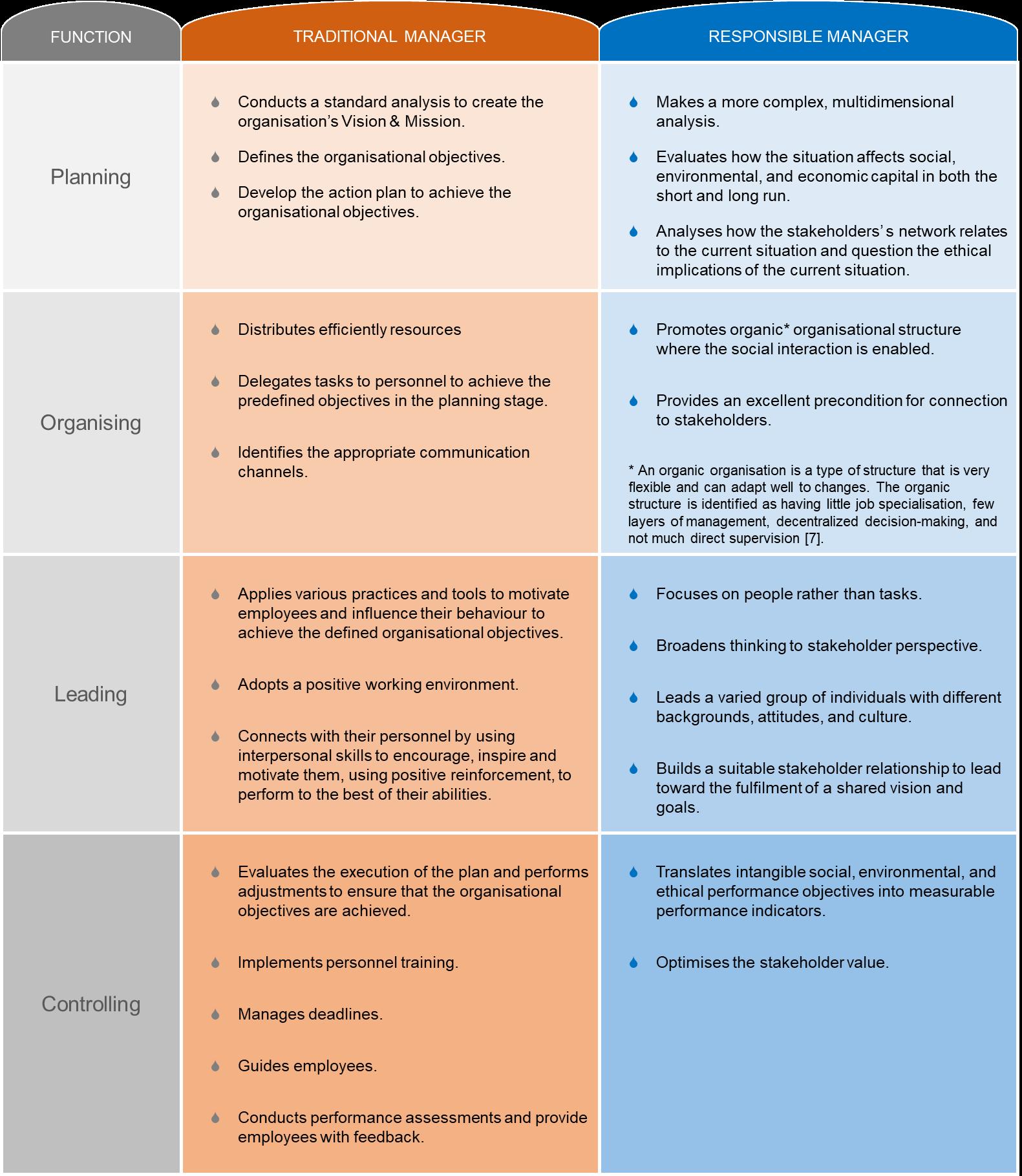
As seen in the previous sections, responsible management is affected by internal conditions that govern the activity of a company. The company hierarchies are only one example of such conditions, but also an important situation is the organisational culture
In addition to the internal conditions, an important role is played by the competencies of a responsible manager. As responsible management evolves from traditional management, managers must evolve too. Responsible managers should acquire a new set of management competencies A successful responsible manager requires a new set of attitudes, beliefs, skills, and knowledge that is, in many cases, very different from the set held by a traditional manager.
The responsible manager should be able to interact with people (social competencies), know his or her domain of responsibility and how to align them with the three domains (sustainability, responsibility, ethics) and the ability to operate methodologically.
Should have a systematic thinking to analyse complex situations and provide an adequate response On the top of that, he/she have to be able to take ethical, sustainable, and responsible decisions. A responsible manager should have empathy for responsibility issues for the stakeholders and have an embracing attitude toward responsible management practices and change.
Using the brainstorming training method, start a discussion with the trainees by answering the question below. The discussion will show whether the three basic concepts have been understood or not.
Sustainable Responsible Management has three domains of operations:
• Sustainability, • Responsibility, and • Ethics.
What do you understand for each one of these domains?

John, the new CEO of a small accounting firm has succeeded a CEO who was there from the first days of the company and most of the company’s personnel are much older than him.
A major digital transformation project has been agreed with the company’s owners as the way to make the company more efficient, more competitive and more sustainable.
However, his initiatives are being faced with mistrust and any changes he tried to implement so far face resistance.
He tried a few traditional approaches, which have improved the overall climate, but resistance is still high. Operating in a regulated sector makes things even more complicated as every change initiative is addressed with suspicion and reluctance.
The personnel are afraid that a digital transformation project may lead to layoffs and/or pay cuts.
Unlike traditional management theories, the Responsible Management approach provides a framework that can enable leaders and organisations to achieve a high degree of influence by allowing them to inspire action. How can John apply responsible management practices and achieve the company’s objectives?
John should apparently start with why? He must explain why the transformation project is important and how it will help the company grow and be sustainable for the future of not only its stakeholders but for the wider society.
How this will be achieved?
John should then delve into the how the project will be implemented and make his colleagues feel the comfort that they will be part of its implementation and the decision making. John should essentially present the process he will follow. He should implement appropriate communication channels, assign tasks and responsibilities, and establish accountability.
Although the company has a specific hierarchy with various managerial levels, he can promote an organic organisational project structure where the social interaction
is enabled and provide an excellent precondition for connection to stakeholders
Finally, John must crystallise the vision of what will actually be achieved by the implementation of the project. He must translate the intangible social, environmental, and ethical performance objectives into measurable performance indicators so everyone can understand what they are about to achieve. Moreover, John must create an emotional appeal with his colleagues by being consistent, authentic, and ethical. He must convey a clear, concise and specific message about the sustainability challenges the organisation is faced and how they can be overcome by implementing the proposed project.
[1] https://link.springer.com/article/10.1007/s10551 021 04945 7
[2] https://www.unpri.org/private-markets/cycle-capital-implementing-a-greenhousegas emissions measurement strategy/9641.article

Responsible management is management that embraces sustainability (triple bottom line), responsibility (Stakeholders Value), and ethics (morally favourable decisions) The three domains of responsible management are: sustainability, responsibility, and ethics.
Responsible managers can be at the centre of a virtuous circle of change in moving toward the achievement of more responsible companies, economies, and societies A responsible manager requires a set of competencies that is different from the set required in mainstream management.
The responsible management process is based on the traditional four management tasks of planning, organizing, leading, and controlling, which evolve around sustainability, responsibility, and ethics
Responsible decision making must assess stakeholder value, triple bottom line impact, and the moral value created by alternative choices.
Responsible leadership is the process of building stakeholder relationships to lead toward the fulfilment of a shared vision and goals
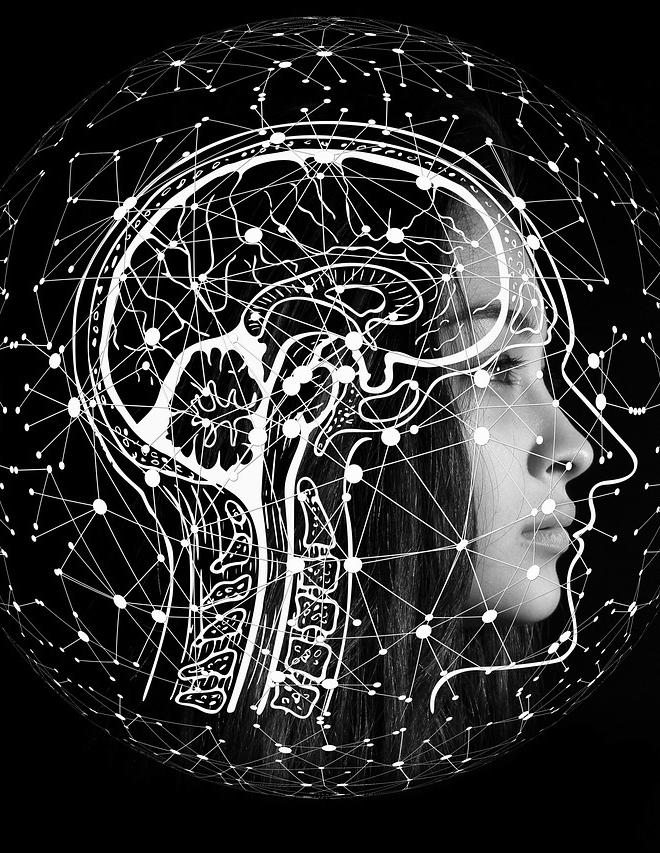
[1] https://insightssuccess.net/new-is/why-is-corporate-social-responsibilityimportant/
[2] Laasch O. & Conaway, R. (2015), Principles of Responsible Management: Global Sustainability, Responsibility, Ethics. Mason: Cengage
[3] Drucker, P. (2001). The essential Drucker. New York: Harper Collins.
[4] Sustainability Management System: The Triple Bottom Line, https://www.eraenvironmental.com/blog/sustainability management triple bottom line
[5] What is sustainability?
https://www.mcgill.ca/sustainability/files/sustainability/what-is-sustainability.pdf
[6] https://www.indeed.com/career-advice/career-development/basic-functions-ofmanagement
[7] https://study.com/academy/lesson/organic organizational structure definition examples-quiz.html
McCauley, C. (2014) Making Leadership Happen, Center for Creative Leadership, Greensborough, North Carolina.
Sustainability Leadership Institute (2011) Definition of Sustainability Leadership, cited in Visser, W. and Courtice, P. (2011) Sustainability Leadership: Linking Theory and Practice, Institute of Sustainability Leadership, University of Cambridge, Cambridge.
If you're interested in reading more about sustainable leadership and innovation, you can find additional learning materials from the TITAN project website.



Website: TITAN | Project Transformation Training to Empower https://titan leadership.eu/
The European Commission’s support for the production of this publication does not constitute an endorsement of the contents, which reflect the views only of the authors, and the Commission cannot be held responsible for any use which may be made of the information contained therein.
Project number: 2020 01 UK01 KA204 079163